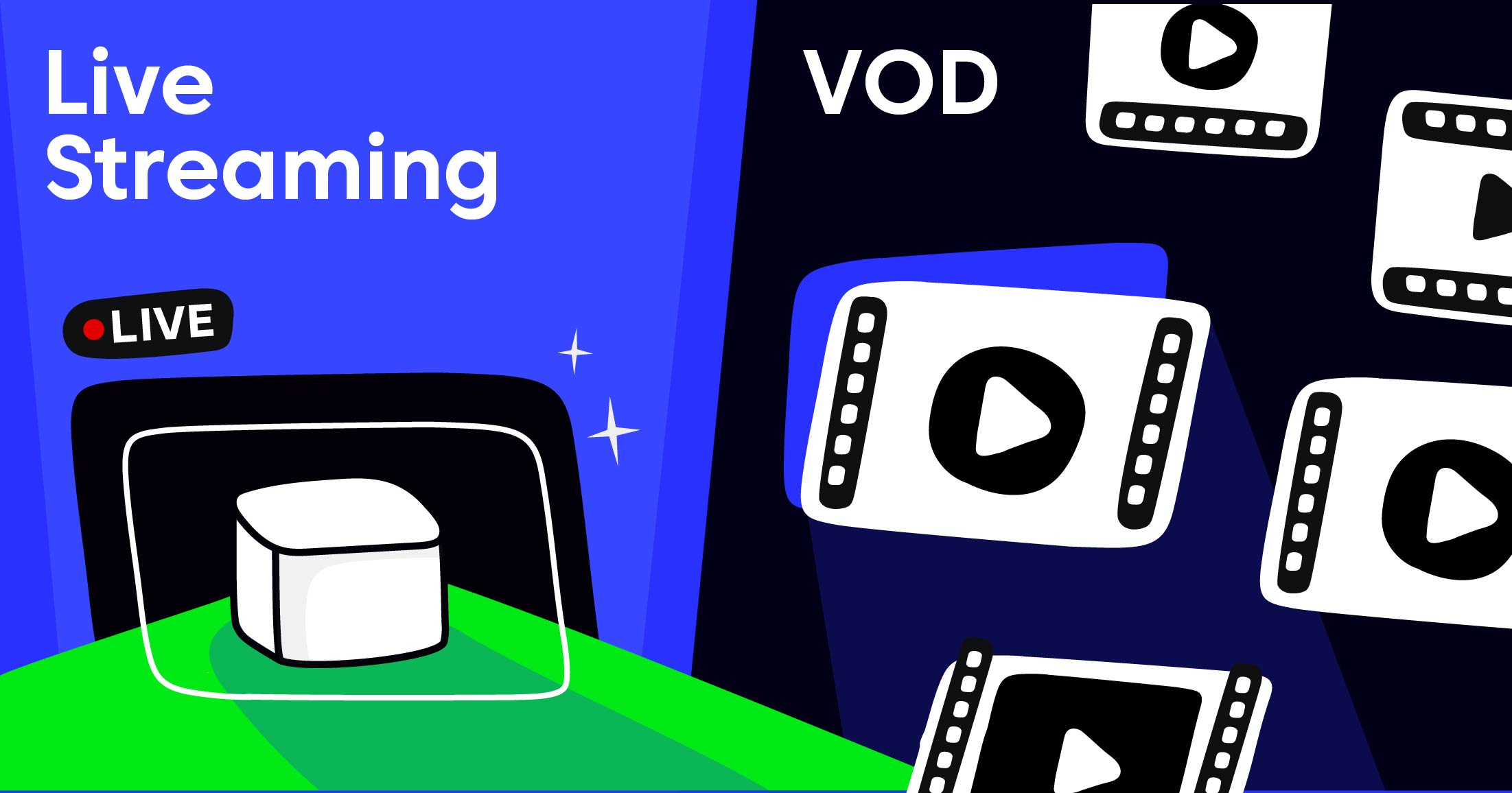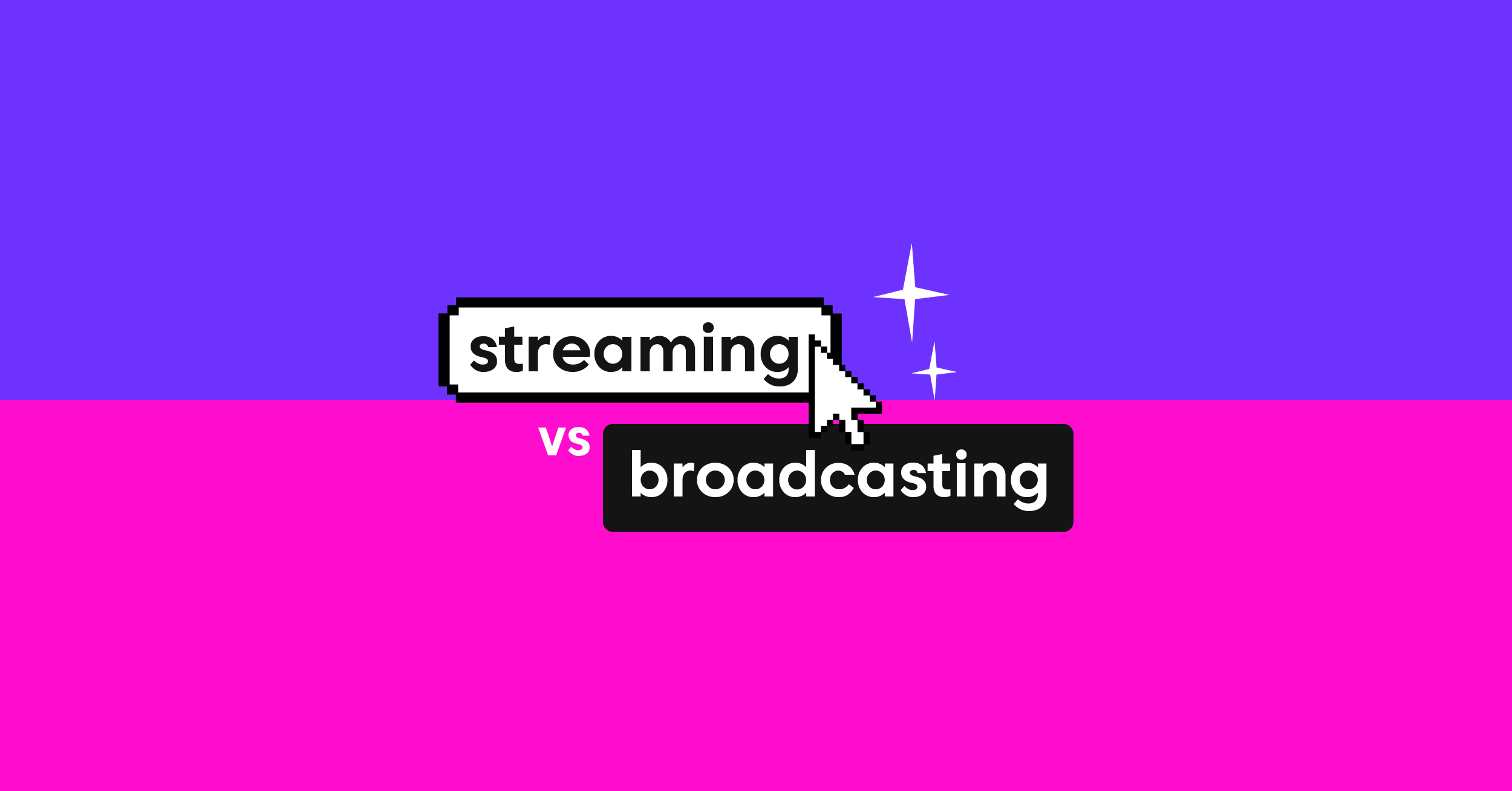The digital entertainment and communication world has seen drastic shifts towards online content. Two platforms have mainly dominated the landscape: Live streaming and video on demand (VOD). As the advancements in video delivery technologies continue, online businesses have experienced a significant revenue boost. The VOD market is projected to reach a staggering revenue of US$159.40bn in 2023, with an expected annual growth rate of 9.71%, resulting in a projected market volume of US$230.90bn by 2027. On the other hand, the live-streaming industry, which boasted a market value of $59.14 billion as of 2021, is expected to almost quadruple, reaching $223.98 billion by 2028.
With such impressive figures, it’s only natural for businesses to explore the potential of both industries. However, to truly leverage these digital communication platforms, it’s crucial to understand the key differences between VOD and live streaming. That’s why this blog post comes in. Let’s dive into the differences between VOD and live streaming.
Comparison table: VOD and Live Streaming
| Feature | VOD | Live Streaming |
|---|---|---|
| Content Availability | Available anytime to watch | Available only during the live event |
| Interactivity | Limited interaction | Real-time interaction possible |
| Content Control | Complete control over content | Less controlled, more spontaneous |
| Revenue Model | Subscription, Ad-Based, or Transactional | Ad-based, Pay-Per-View |
| Technological Requirements | Less demanding content can be optimized for lower internet speeds | Requires strong internet connection for quality experience |
| Content Duration | Typically shorter, pre-recorded video segments | It can be lengthy; entire events are streamed live |
| Post Production | Allows for editing, enhancing video quality | No post-production, more susceptible to errors |
| User Experience | Users can control the pace, rewind, or fast-forward content | User-bound to the real-time pace of the live broadcast |
| Content-Type | Movie, course, training programs, etc. | Sporting event, concert, live event, etc. |
| Monetization | More aggressively monetized through multiple channels | Primarily monetized through ads and pay-per-view |
What does VOD stand for?
VOD stands for Video on Demand. VOD is a digital media distribution system. It allows users to select and watch videos when they want. Users can pause, fast forward, or rewind films. Users can watch videos whenever they choose.

VOD offers an array of video content. Users can select movies, documentaries, and TV shows. They can also view video clips, news broadcasts, sports games, and more. All this content is available to stream on internet-connected devices. These include smart TVs, computers, or mobile devices.
VOD’s strength lies in its convenience. It liberates viewers from traditional methods. Now, individuals no longer need to adhere to strict cable TV schedules. Instead, they can curate their video playlists. They can watch videos at their own pace.
How does VOD work?
VOD operates via streaming platforms. It uses an internet connection to deliver video content. VOD works differently than Live streaming. It involves a different video delivery process.
In VOD, video files are stored on a server in pre-recorded format. No real-time broadcasting takes place. When a user requests content, the server sends it over the Internet. This allows users to access the content on demand.
Streaming video in VOD involves a technical process. The video file gets fragmented. Each segment is encoded at multiple bitrates. This is a process called adaptive bitrate streaming. It ensures optimal video quality on various internet speeds.
Users can start, stop, pause, or replay videos anytime. This is possible because the file is pre-recorded. The videos are stored on the server. This allows for stored video streams to be sent to users upon demand.
The VOD system taps into powerful video platforms. This allows for efficient video delivery to many users at once. VOD can handle multiple demands simultaneously. VOD guarantees a smoother, high-quality viewing experience. This is adjusted to the user’s internet speed.
VOD operates on a simple principle. It offers flexible, enjoyable, and in-depth content. All at the user’s demand. The clear advantage of VOD lies in its convenience and flexibility. It allows access to a wide array of content. This is accessible whenever and wherever the user wants.
What Types of Video on Demand Models Exist?
In the world of Video on Demand, there are multiple business models. These models are designed to optimize content creator revenue. They focus on user engagement and viewing habits. Today, we’ll discuss three significant VOD models. They are Subscription Video on Demand (SVOD), Ad-Based Video on Demand (AVOD), and Transactional Video on Demand (TVOD).
Subscription Video on Demand (SVOD)
SVOD is a popular model amongst VOD platforms. It operates based on subscriptions. Users pay a recurring fee for the service. This could be charged weekly, monthly, or annually.
Once subscribed, users gain unlimited access to the platform’s video collection. This is available any day or time. Users can watch videos from a variety of categories. They can access videos from movies to documentaries to TV series and more. Prominent examples of SVOD platforms are Netflix and Amazon Prime.
SVOD offers several user advantages. It delivers the convenience of choice. It also offers uninterrupted viewing. No commercials disturb the viewing process. However, for unlimited viewing, an active subscription is necessary.
For platform operators, SVOD provides a stable revenue source. The recurring fees offer financial comfort. It’s a predictable income stream. Consumers’ love for fresh content also means more revenue.
Ad-Based Video on Demand (AVOD)
AVOD has a different revenue generation approach. It provides free content to users. Revenue comes primarily from advertisements. These ads appear during the video playback. Known platforms like YouTube and some segments of Hulu use this model.
Users benefit from AVOD by gaining free access to videos. In this case, they exchange their viewing time against advertisements. Users receive content without direct charge. However, repetitive or poorly placed ads can hinder user experience.
For content providers, AVOD guarantees wide reach. The potential for mass market penetration is excellent. The model also tends towards high returns in densely-populated regions.
Transactional Video on Demand (TVOD)
TVOD falls under the pay-per-view category. Here, users only pay for the content they want to see. No fixed or recurring payments are required. This model is split into two sub-models: Electronic sell-through (EST) and Download-to-rent (DTR).
EST allows users to buy a video permanently. They can then watch it unlimited times. DTR allows users to rent a video for a specific period. Prominent TVOD platform examples are iTunes and Google Play.
TVOD appeals to users who watch content occasionally. They might want to access specific video content. They may also want to purchase high-priced premium content.
From the operator’s view, TVOD allows platforms to generate revenue from every video. It can be a manageable library of content. The right blend of quality and compelling content can drive significant revenue.
These models showcase the flexibility of the VOD system. With user-centric monetization strategies, VOD allows content creators to make revenue. It can thus appeal to a diverse range of audience types. Providers must choose the best model suited to their business goals and target audience. They should also consider the quality and quantity of their content. It is essential to offer a user-friendly interface and seamless streaming service. All this leads to maximized revenue and better user engagement.
Benefits of VOD for Your Business
Video on Demand brings many advantages to businesses. Let’s explore how VOD offers opportunities for businesses to grow and engage their audiences.
Access to a Wider Audience
The first benefit of VOD is its reach. It has a global audience. This means a business’s video content can reach viewers worldwide. An internet connection is all you need. Various streaming platforms exist where businesses can host their videos. VOD content offers viewers flexibility. They can watch videos at their convenience. This means businesses have a constant presence in their viewers’ lives.
Monetization Opportunities
VOD can generate substantial revenue. This is possible through several monetization models we have discussed. SVOD, AVOD, and TVOD provide various ways to generate income. Businesses can choose the most suitable model for their content. They can consider their audience’s viewing habits. This choice will maximize revenue.
Low Operational Costs
VOD is more economical than traditional television distribution. Physical infrastructure is optional. This cuts down costs. Distribution is more accessible and scalable. Additionally, content is available 24/7. VOD does not require broadcasting equipment or staff to operate. The reduction in costs leads to a higher margin of profits.
Improved User Experience
VOD means no commercial disturbances. It also means no strict schedule. These are the pain points of traditional cable TV. VOD helps businesses overcome these pain points. Unlimited availability provides a better viewing experience. Users can view, pause, rewind, or fast-forward video content. This grants users control over what they wish to watch.
Viewer Insights and Personalization
VOD platforms offer insightful analytics. They provide data about audience behavior and interests. This includes viewing times, length, and preferred content. These analytics help businesses tailor their content. They can create personalized recommendations. This increases user engagement.
Potential for Growth and Innovation
As the VOD market grows, so does its potential. It’s expected to reach US$230.90 billion by 2027. VOD is a growing platform for video content. For businesses, this means room for growth and innovation. VOD caters to a variety of niches. It fosters creativity in curating and distributing content.
Accessibility For Everyone
Businesses can reach a wider audience. This includes differently-abled individuals. VOD content can have captions for those who are hearing impaired. It can have audio descriptions for those who are visually impaired. This makes content accessible to a wider range of audiences.
Marketing Opportunities
Lastly, VOD opens up new marketing opportunities. Businesses can promote their products through video content. They can create engaging narratives. It allows for innovative digital marketing strategies with a global reach.
The benefits of VOD for businesses are vast. From economic efficiency to revenue generation, VOD provides a win-win solution. It improves user experience while boosting business profits. As digital consumers increase, leveraging VOD will become crucial for business growth.
Limitations of Video On Demand
While VOD has several advantages, it also has limitations. Let’s explore the challenges businesses might face while employing VOD.
High-Quality Needs High Speeds
The quality of the video plays a crucial role in the viewing experience. High-quality VOD content requires a high-speed internet connection. A good internet connection can help the viewing experience. This is a concern, particularly in regions with limited internet access.
Copyright Challenges
VOD requires businesses to navigate copyright laws. Copyright holders must grant rights to the video content. This process can be complex and time-consuming. It requires businesses to invest in legal knowledge and expenses.
Competition and Saturation
The VOD market is highly competitive. Many dominant players already exist. New entrants need to create a unique edge to stand out. Furthermore, with the content explosion, audiences may be overwhelmed. The challenge lies in creating unique, engaging content.
Technology Infrastructure
While implementing a VOD system can be more economical, it has costs. A robust technological infrastructure is necessary to deliver smooth streaming. This requires investment in servers, video platform technology, and maintenance.
Audience Retention
While VOD allows viewers to watch content anytime, it challenges audience retention. Because audiences can stop viewing at any moment, keeping them engaged throughout the video might be difficult. Creating a compelling narrative becomes crucial in VOD content.
While VOD streaming offers numerous opportunities, it’s challenging. Understanding these limitations is crucial. This can help businesses devise strategies to minimize their impact and profitably leverage VOD’s benefits.
What is Live Streaming?
Live streaming involves broadcasting video content in real-time over the Internet. It is quite different from VOD. Unlike VOD, it doesn’t involve pre-recorded content. Instead, viewers watch the live-stream content as it happens. Live video streaming delivers digital content immediately. This happens without the need for storage or download.

Live streams are real-time videos. They capture, process, and deliver content continuously. This happens without interruptions to the flow of data. Examples of live streams are webinars, concerts, and sports events. It could also be conferences or online gaming streams.
Users access live-streaming content on various devices. These include desktop PCs, laptops, smartphones, tablets, and smart TVs. An internet connection is all that is required.
For a smooth live stream, encoding software is needed. This is used to compress the video data. Then, it is sent to a server. From the server, it goes directly to the viewer’s device.
Live streaming is popular on various streaming platforms. YouTube Live, Facebook Live, and Twitch offer live streaming services. These platforms allow content creators to reach their audience in real-time.
Live streaming is a dynamic way to share content. It is live, real-time, and engaging. It offers a personal touch to digital content. Live streams create room for real-time interaction and feedback. This makes it a powerful tool for businesses and content creators. Live streaming has transformed the landscape of digital communication. It continues to provide exciting opportunities for interactive, engaging content delivery.
How Live Streaming Works
Live streaming involves various steps. It requires a blend of technology and strategy. Let’s explore how it works.
Capture
The first step is to capture the video content. This could be an event, presentation, or a game. A digital camera or a smartphone typically does this capturing.
Encoding
The next step is encoding. This involves converting the video input into a digital format. A software or a hardware encoder can do this. The encoder compresses the video file to ensure smooth delivery via the Internet.
Broadcasting
Once encoded, the video file goes to a streaming platform. The platform processes the video data. Then, it shares the video over the Internet. Broadcasting occurs in real-time. The platform uses adaptive bitrate streaming for this purpose. It adjusts video quality according to the viewer’s internet speed.
Viewing
Finally, the live stream is available online. Viewers can access live-streaming videos from anywhere. They only need an internet-connected device, such as a mobile device or computer.
There are several live-streaming platforms available. Examples include YouTube Live, Facebook Live, and Twitch. These platforms provide the infrastructure necessary for online streaming. They offer live streaming solutions and services. These services vary depending on the platform. They range from the type of content allowed to monetization models and audience engagement tools.
Live Streaming Events Strategy
A successful live-streaming events strategy is crucial. This involves careful planning before, during, and after the event. The pre-event strategy includes marketing the live stream and testing the tech setup. It also includes preparing the content.
During the event, engaging with the audience is crucial. Real-time chat features, Q&A sessions, or polls can do this. It’s important to monitor the live stream for any technical hiccups.
The post-event strategy involves analyzing viewer data. Various analytics are available to measure audience engagement. These insights help to improve future live streams.
Live streaming is a complex process. It requires specific technology and planning. But the real-time interaction and audience engagement it provides make the effort worthwhile. Whether for businesses, institutions, or influencers, live streams offer a dynamic approach to digital communication.
Benefits of Live Streaming
Live streaming offers unique benefits. It can drive customer engagement and business growth. Let’s explore some of these advantages.
Real-Time Engagement
One of the biggest advantages of live streaming is real-time engagement. Businesses can have direct communication with their global audience. This engagement is immediate and interactive. It fosters a strong connection with the audience. As a result, businesses can improve customer relationships and brand loyalty.
Cost-Effective
Compared to traditional events, live-streamed events are cost-effective. There’s no need for physical locations or logistics. Live streaming events mean fewer resources and less time spent on organization. The savings can be significant. Businesses can reach a wider audience with a smaller budget.
Expanding Audience Reach
A live-streaming platform lifts geographical barriers. Businesses can reach a global audience. An internet connection is all that’s necessary. This means that businesses can expand their audience reach significantly. They can share their message with people around the world.
Direct Feedback and Interaction
Live streaming allows for instant feedback. Businesses can interact with their viewers directly. They can respond to comments and questions in real-time. This direct interaction offers valuable insights. Businesses can understand their audience better. They can adjust their live-streaming strategy accordingly.
Increases Online Presence
Live streaming helps to increase online presence. High-quality, engaging live streams can drive traffic. They can boost a business’s online visibility. This visibility can attract new customers. It can also improve search engine rankings.
Provides Unique Content
Live streams produce unique content. Viewers get real-time access to content they can’t get elsewhere. This uniqueness can differentiate a business from competitors. Live streaming a conference, a product launch, or a Q&A session provides unique value. It encourages viewers to tune in for the exclusive experience.
Monetization Opportunities
Live streaming also offers monetization opportunities. Advertisements, sponsored content, and pay-per-view are some options. This, combined with the cost-effectiveness of live streaming, can lead to excellent ROI.
Live streaming offers valuable benefits. From cost savings to increased engagement, it’s a powerful tool in the digital world. Given the growth of live streaming, understanding and leveraging its benefits is vital. A well-planned live-streaming strategy can boost a business’s reach and revenue. It can improve the customer experience and differentiate the brand in a crowded digital marketplace.
Limitation of Live Streaming
While live streaming offers significant benefits, it does have limitations. Let’s explore some of the challenges related to live streaming.
Technical Issues
Live streaming requires a stable internet connection. Any disruptions can affect the quality of the stream. This may lead to buffering or poor video quality. Viewers could also experience a delay. These technical issues can degrade the viewer experience.
Lack of Control
Unlike VOD, live streaming offers less control over content. Everything is broadcast in real-time. There are no chances for edits or corrections. Any mistakes made during the livestream are immediately visible to the audience.
Schedules
Specific schedules bind live streaming. Viewers need to tune in at set times. VOD is more flexible than this, where viewers can watch content conveniently. Therefore, it is critical to choose a suitable time for live streaming. You need to accommodate viewers spread across various time zones.
Requires Planning
Successful live streaming requires detailed planning. This includes promoting the event, maintaining stability during broadcasting, and engaging the audience. The planning and resources required for live streaming can be a limitation.
Limited Monetization Options
Compared to VOD, live streaming has fewer monetization options. The majority of monetization comes through ads and sponsorships during the event. There is also less opportunity to monetize through subscription or transactional models.
Live Streaming vs VOD: Which is the best?
Deciding between VOD and live streaming depends on various factors. Both have unique features, advantages, and purposes. But the “best” choice depends on the specific needs of your business or content strategy.
From a perspective of usage purposes, VOD is ideal for evergreen content. These are contents viewers can access over a prolonged period. Think tutorials, TV series, documentaries, or movies. If you require flexibility for your viewers, VOD stands out. Viewers can watch the content anytime, anywhere.
On the other hand, live streaming is excellent for real-time events. These include webinars, sports events, concerts, or product launches. Live streaming is your go-to solution if you’re targeting real-time engagement and interaction.
In terms of features, both come with distinctive offerings. VOD allows for post-production enhancements. Live streaming doesn’t. But live streaming provides real-time interaction with the audience.
In considering benefits, VOD offers flexibility and control over content. It provides a user-driven viewing experience. Live streaming, conversely, delivers real-time excitement. It gives an authentic and engaging viewer experience. Real-time interaction can foster stronger audience relationships.
VOD and live streaming serve different purposes. Identify your content goals first. Then, consider the advantages of each. This will help you determine whether VOD, live streaming, or combining both is best for your digital content strategy. After all, they are not mutually exclusive. A blend of both could give your audience a diversified and engaging content experience.
Castr: Easy and Powerful Video Streaming Solution
Castr is a cloud-based platform that lets you stream live video and audio to multiple platforms and devices at once. You can also upload, store, and manage your video-on-demand (VOD) content in one place. One of the most useful features Castr offers is the ability to turn your live streams into video-on-demand (VOD) content. With the Live to VOD tool, your live video is automatically saved and converted into an on-demand video that viewers can replay, rewind, fast forward, and pause whenever they want. So if someone misses your live stream or wants to go back and rewatch a specific moment, they can do so easily, thanks to the VOD version your live video gets turned into. This makes your content more evergreen and valuable even after you stop broadcasting live.
Whether you want to stream live events, webinars, podcasts, or gaming sessions or create a video library for your audience, Castr can help you achieve your goals. You can start with a free trial and upgrade to a plan that suits your needs. Sign up and try Castr today!









